To understand the device IPS technology, you need to start directly from the LCD panel itself. It combines two modules: LED-backlight and a matrix consisting of liquid crystals, which creates an image.
The principle of operation of such a panel is based on changing the intensity of light. Coming from the backlight module and passing between two plates of polarized glass, the light changes its intensity in the crystalline matrix depending on the degree of voltage of the electric discharge. In fact, liquid crystals are spun at a certain angle and pass through the glass plate and the color filter only the required amount of light. This ensures the display of the picture that we see on the TV screen.
The general structure of LCD panels is quite similar, but the differences begin when we talk about the nuances of the polarization of light passing through liquid crystals. The characteristics of the matrix - for example, viewing angles - depend on the way the crystals are oriented in space.
- 1 Polarizer
- 2 Glass
- 3 Color filter
- 4 Liquid crystals
- 5 Glass
- 6 Polarizer
- 7 Rear
illumination
LCD panel
IPS (from English In-Plane Switching)
A technology for creating liquid crystal panels in which the crystals operate in the same plane between the substrate and the polarizer. At rest, the crystals are “closed” and exhibit black color, and when voltage (E) is applied, they rotate through a certain angle (up to 90 degrees) and allow the required amount of light to pass through. Since the rotation occurs in the same plane, the IPS LCD panel looks stable from different angles.
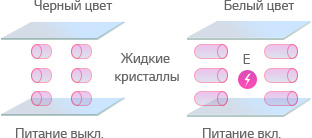
Application
Today, IPS technology is extremely popular, it is used in displays everywhere. It can be found on the screens of TVs, monitors, laptops, mobile devices - almost everywhere where you need a high-quality color display with wide viewing angles. IPS technology has received a special status from graphic designers, as it provides stable color reproduction characteristics regardless of the position of the viewer relative to the screen.
TECHNICAL INFORMATION
A typical IPS LCD uses a thin-film transistor (TFT) substrate to drive pixels. Each pixel contains three RGB filters that extract the desired color from the white LED backlight. In some models, quantum dots can be added to conventional light filters, highlighting a wider range of RGB. The color image received on IPS can have a depth of up to 10 bits per color channel.
Comparative characteristics
Color displays on IPS LCD panels have certain advantages over other varieties of LCDs. The main thing IPS property- the ability to demonstrate a stable picture at different angles due to the fact that liquid crystals work in the same plane. The image remains clear and legible regardless of the position of the viewer relative to the screen, ensuring optimal color reproduction.
The response time of IPS technology approaches the fastest LCD panels, so there are no loops or other artifacts in the dynamic image. Another advantage of IPS is the high light transmittance when the crystals are in the "open" state. Due to this, the backlight power is used more efficiently. At the same backlight level, the IPS image becomes brighter than other LED LCD technologies, which means that the TV consumes less power.
To date, technology IPS and Super AMOLED are the optimal solution for the production of smartphone screens and tablet computers. It is these screens that are installed on the flagship models of smartphones from leading manufacturers. So, for example, on the iPhone 5, there is a display with a matrix IPS. And Samsung's latest flagship, the Galaxy S4, comes with a screen Super AMOLED.
Features of IPS technology
IPS is an advanced liquid crystal display technology. Unlike conventional LCD monitors, IPS provide a wide viewing angle (up to 178 degrees). There is also increased contrast good quality color reproduction and solves the problem of deep black transmission, which is typical for conventional liquid crystal matrices. A characteristic feature of liquid crystal displays is the need to place a special backlight behind the matrix. The fact is that liquid crystals themselves do not emit light. Therefore, in order for the image to be noticeable, it is necessary to highlight it from the inside.
Features of SUPER AMOLED technology
Super AMOLED is a technology based on the action of organic light emitting diodes. Unlike LCDs, these screens offer a 180-degree viewing angle with no loss in brightness or contrast. Super AMOLED technology has managed to overcome the most important disadvantage old AMOLED displays - problems with readability in the sun and glare. AMOLED displays consisted of several layers TFT matrices, between which there was a so-called air gap. Super AMOLED implies the presence of only one layer, that is, no air gaps. Super AMOLED allows you to achieve exceptional thinness of the display, as well as an increase in brightness by approximately 20%. It is worth noting the reduction in energy consumption relative to its predecessors. By the way, the technology Super AMOLED allows you to create flexible displays, which such strong brands as Apple and Samsung so often mention in their plans.
What is better?
Both technologies have both advantages and disadvantages. So, for example, the production of displays using technology IPS is quite expensive, but such screens are brighter and practically do not glare in the sun.
There are also advantages Super AMOLED. First of all - it's high contrast and excellent color reproduction. The low cost of production of such displays favorably distinguishes them from liquid crystal displays. Also, they do not require additional illumination in the form of LEDs located behind the matrix, so ultra-thin gadgets can be produced on their basis. Naturally, the lack of backlight allows you to reduce power consumption, which for autonomous mobile devices, of course, is of great importance.
In general, while giving the palm to one of the types of screens, you should not rush. In addition, these most popular technologies today are gradually catching up with color electronic ink displays - more economical and contrast, but not yet fast enough to play video.
Two things prompted me to create this article: numerous speculations by marketers and specialized journalists on the topic of screens; and a bunch of exactly the same comment threads under smartphone reviews with exactly the same discussions about which matrices are better. Usually, the hottest happens under the reviews Chinese phones with OLED screens. I'm tired of fighting windmills, talking to each reader individually, in this article I decided to dot all i's and dispel numerous myths about modern screens, looking ahead, I'll say that the emphasis will be on the confrontation between IPS and AMOLED matrices. Most likely, most of you will not see anything new in what is written, you will not receive sacred knowledge here, as well as a breakdown of the covers. I will talk about obvious things that neither bloggers nor journalists want to talk about. The guide is designed for adequate thinking people, convinced fanatics can go about their business.
Definition of the term “screen”
Before getting to the point, it is necessary to define the term screen and clarify its functional purpose. Wikipedia tells us that a screen or display is electronic device, intended for visual display of information. If you try to give a less concise and more modern definition of the screen in terms of functionality and with an emphasis on consumer properties, it will turn out something like this: a screen is a device whose task is to display all kinds of content and user interface of operating systems and applications as accurately and in detail as possible. what the authors intended. Physical resolution is responsible for “as detailed as possible”, otherwise: the number of smallest screen elements (picture’s elements) or simply pixels (pixels), the higher the resolution, the better, ideally it should be infinitely large. Parameters such as color accuracy and contrast, or the ratio of the lightest and darkest point on the screen, are responsible for “as accurately as possible”. Secondary parameters that do not directly affect either the accuracy or the detail of the display of information, but affect the consumer properties of the screen, include: maximum brightness, image distortion when the gaze deviates from the perpendicular, reflection coefficient, image refresh rate, response time, energy efficiency and some others. . Standing apart is such a parameter as color gamut - the most important parameter for professional monitors and practically meaningless for devices intended for content consumption. But it is the color gamut that has been the subject of much speculation by manufacturers in recent years. mobile gadgets. Let's clear up this murky topic before moving on.
What is color gamut and why is it the subject of much speculation
You need to start with the fact that any image is encoded when captured and stored in the memory of a photo or video camera. Artificially generated pictures and clips, as well as parts of the graphical user interface of operating systems and applications, are coded in a similar way initially. In both cases, color information is represented using a color model, a special mathematical tool for describing color using numbers or, to be precise, coordinates. The most common is the three-dimensional RGB model, in which each color is described by a set of three coordinates responsible for one of the colors: red, green and blue, the displayed hue depends on the ratio of the brightness of each of the components. Modern screens are capable of displaying only a part of the spectrum of colors and shades visible to a person, color gamut literally means how big this “part” is. Due to this limitation, a person is forced to create standards for the representation of the color spectrum, starting from the capabilities of existing screens. So in 1996, to unify the use of the RGB model in monitors and printing, HP and Microsoft developed the sRGB standard, which used the primary colors described by the BT.709 standard common at that time on television and gamma correction designed for cathode ray tube monitors. It is important to understand that such unification allows, albeit with some reservations, to guarantee that the content creator and consumer will see approximately the same thing on their screens. Subsequently, the sRGB standard has become widespread in all areas of content production, including the creation of Internet sites. Of course, there are other standards for representing the color spectrum, such as Adobe RGB, which has a much wider color gamut, but today the vast majority of content is encoded in accordance with sRGB.
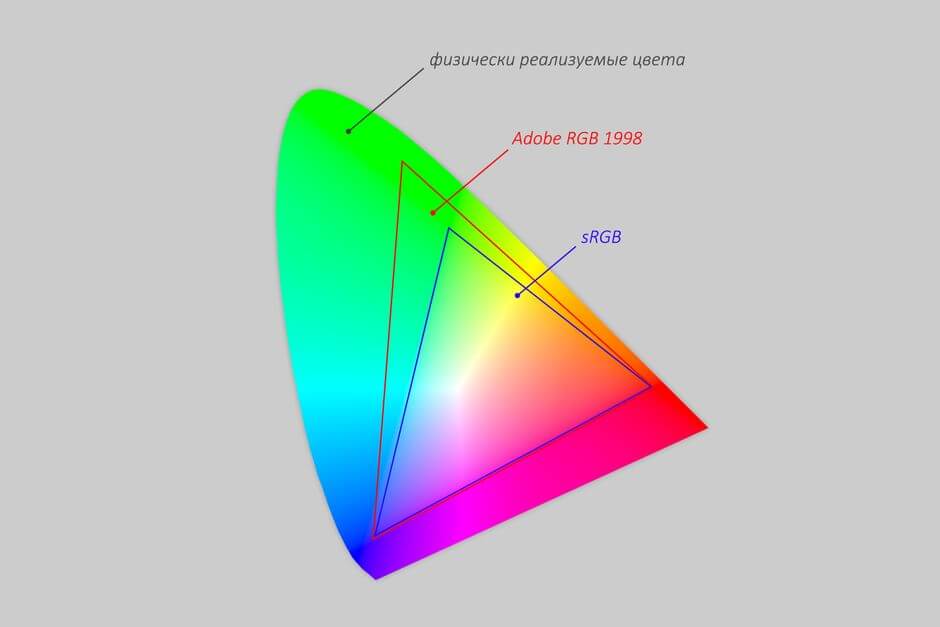
What happens if sRGB content is viewed on a screen with a wider color gamut without adaptation? The sRGB space coordinates will be transferred to the screen's color space coordinate system, causing colors to appear more saturated than they really are, in some cases the hues are distorted so much that orange becomes red, lime green, and blue blue. Conversely, if content with a wider color gamut is viewed on an sRGB screen, coordinate shifting will cause the colors to appear less saturated than they should be.
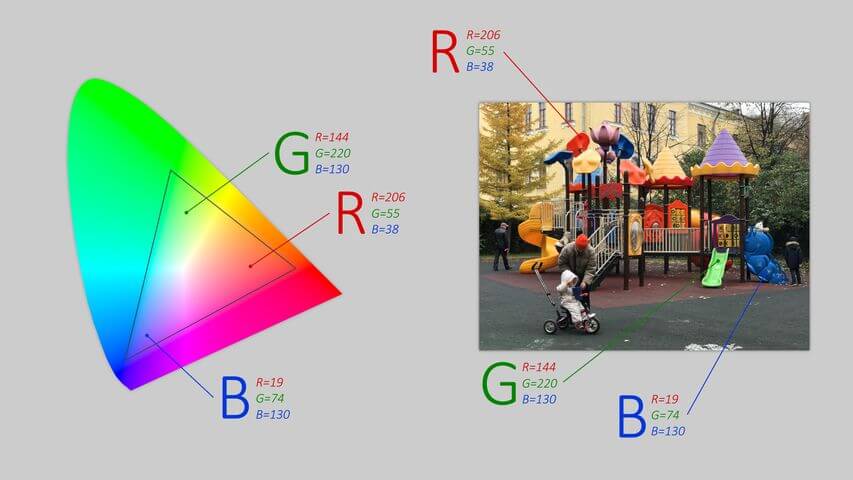
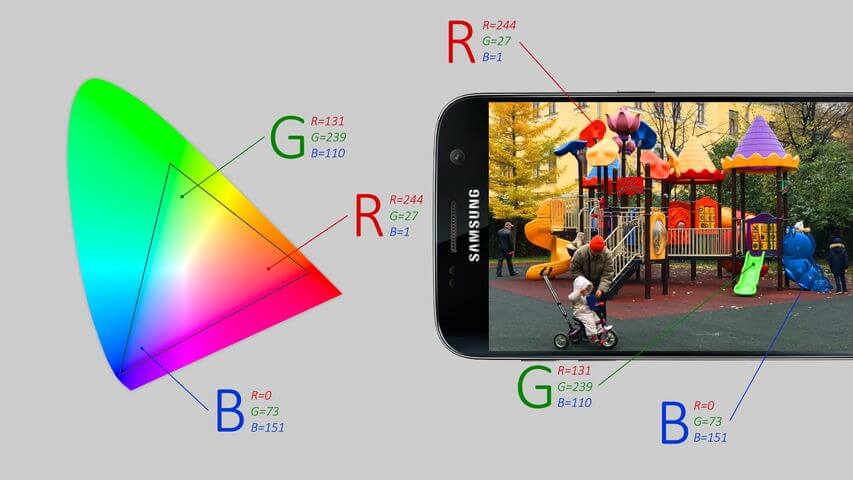
We all know that the screens of most modern flagship smartphones have an extended color gamut relative to sRGB, how does this affect their consumer properties? If it is a smartphone or tablet on android, then there are three options. At best, the shell settings will contain preset color profiles, among which there is one that brings the space to the sRGB standard, MIUI or Samsung's shell can serve as an example. But, even in this case, the application of profiles "on the fly" is impossible, and the user will have to choose between the extended color gamut and the correct color rendering. The second option is when there are no built-in profiles in the system, but you can activate the sRGB mode in the developer settings, for example, this can be done on Google smartphones Pixel and OnePlus 3T. Unfortunately, GUI operating system when activated, the sRGB mode becomes faded, as it is encoded in accordance with the color gamut of their screens. In the third worst case, the user will not find any profiles in the system and, accordingly, will not receive any choice, he will only have to enjoy oversaturated colors. But in personal computers there is no such problem on Windows and MacOS, since both systems not only support color profiles, but can also convert colors from one space to another on the fly, that is, regardless of what content and on which screen it will be displayed, the user with some reservations will see the colors as they were intended by the author. A similar color profile management system exists in iOS. Manufacturers, either for the sake of beautiful numbers on the specifications page, or just for the sake of it, continue to install IPS and OLED screens with extended color gamut, despite the fact that there is no need for this, since 99% of the content complies with the sRGB standard and the situation is unlikely to change radically in the near future. There are simply no tasks that such screens can perform in devices designed for content consumption. All this would make at least some sense if Google added color profile management to Android, as Apple did, but at least in 2017 we will not see this. The irony lies in the fact that the problem was created from scratch, and no one is in a hurry to solve it.

Liquid crystal screen: principle of operation; Advantages and disadvantages
Twenty years ago, cathode ray tube screens were installed in most monitors and televisions, they were soon replaced by liquid crystal screens or LCD (liquid crystal display), which over time received several branches of development and today there are three technologies for the production of liquid crystal matrices screens: TN, MVA and IPS, the latter, due to a successful combination of advantages and disadvantages, has become dominant in the mobile technology segment. The principle of operation of the LCD is simple, depending on the manufacturing technology, some details may vary, but a typical matrix includes a backlight and six other layers. First behind the lamp is a vertical filter that polarizes the light accordingly. It is followed by two layers of electrodes with a layer of liquid crystals located between them, the voltage applied to the electrodes orients the crystals and they refract light in such a way that it passes or does not pass through the next layer - a horizontal polarizing filter. The last color filter is red, green or blue. LCD screens are lighter, more compact and more energy efficient than their predecessors, but they also have a number of serious drawbacks, in particular, low contrast and black depth, limited color gamut even in potential, which depends on the imperfection of backlight lamps. In addition, brightness and contrast performance may deteriorate if you look at the screen not at a right angle.

OLED Screen: Advantages, Disadvantages, PWM, Pentile
Relatively recently, LCD has a serious competitor - these are screens with an active matrix on organic light-emitting diodes or AMOLED. Such screens are fundamentally different from LCDs in that the light source in them is not a backlight, but each subpixel separately, which gives AMOLED many advantages over liquid crystal screens, the main of which are: almost infinite contrast; lower power consumption when displaying images with a predominance of dark tones; potentially wider color gamut; and smaller dimensions. First AMOLED screens in addition to the advantages, they also had significant disadvantages, including: inaccurate color reproduction; fast burnout of LEDs; high power consumption when displaying images with a predominance of light tones; flickering due to pulse width modulation; and most importantly, the high cost of production. Over time, most of the shortcomings were able to overcome or minimize them, except for PWM, which to this day is the Achilles' heel of technology. Pulse Width Modulation or PWM is one way to adjust the brightness of LEDs, the side effect of which is to flicker the screen at a certain frequency. Most people are not susceptible to this kind of flicker, but PWM can cause eye fatigue and even headaches for some users. It is important to note that the flickering effect is completely absent at brightness values close to the maximum and begins to appear at a brightness level of 80% and below.
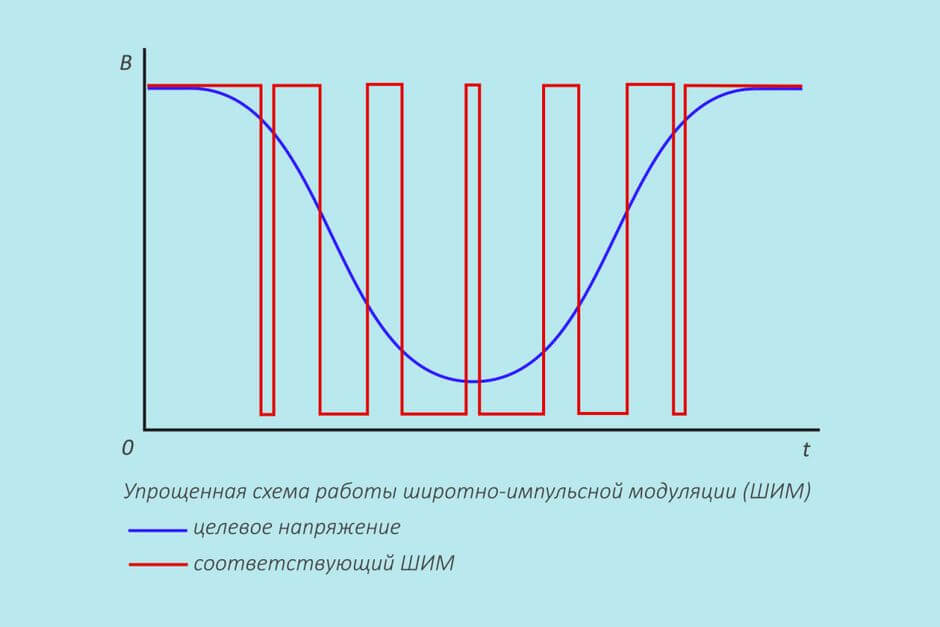
It is impossible to get past the topic with the organization of subpixels in OLED screens, the fact is that most AMOLED matrices have subpixels arranged according to the RGBG scheme, when a pixel does not consist of three subpixels as in a typical LCD screen, and out of four: red, blue and two green, this scheme is also called Pentile. The manufacturer (Samsung) considers the physical resolution of such screens to be exactly two times less by the number of green subpixels, red and blue subpixels in the matrix. Obviously, at least three full-fledged subpixels are needed to obtain a hue. Thus, the effective resolution of such screens is not equal to the nominal resolution specified in the official specification. For example, for a QHD screen, the nominal resolution is 2560 * 1440 pixels, the resolution based on the number of red and blue subpixels will be approximately 1811 * 1018:
The effective resolution of such a matrix, taking into account the tricky interpolation algorithms embedded in the screen controller, is somewhere between 1811 * 1018 and 2560 * 1440, we can assume that it corresponds to FullHD resolution in RGB matrices. It may very well be that for such a match, Samsung has been choosing QHD resolution for its flagship smartphones for many years in a row.
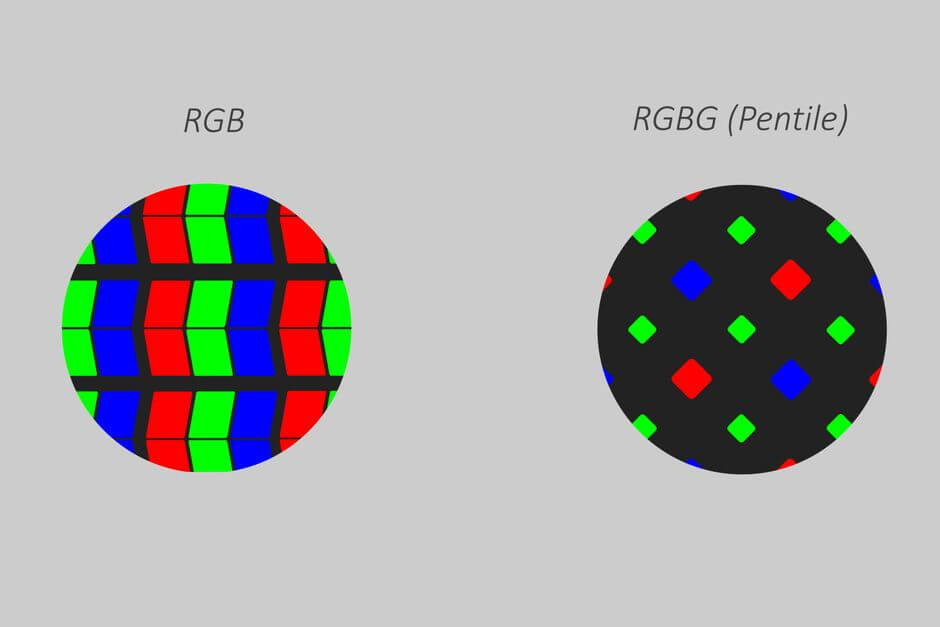
A detailed comparison of IPS and AMOLED on the example of iPhone 7 and Galaxy S8 smartphone screens
Now after we have learned all about the characteristics of the screens and the features different types matrices, you can go to the main question: which technology is better? I am sure it is correct to try to answer this question by comparing best AMOLED and IPS matrices currently available, namely the screens of smartphones Samsung Galaxy S8 and Apple iPhone 7. Since I have not yet acquired test equipment, I will analyze the test results taken from an authoritative resource. Let's start with resolution, Galaxy S8 screen is 2960*1440 pixels, guaranteed effective resolution is 2094*1018, guaranteed effective pixel density is 403 per inch. The iPhone 7 Plus has a nominal effective resolution less: 1920 * 1080, and an effective pixel density of 401 per inch. The advantage in favor of the screen from the Korean vendor is obvious. The resolution of both screens is sufficient for everyday use and not enough for comfortable use with helmets virtual reality. Moving on to accuracy, the contrast ratio of the Galaxy S8 is almost infinite. The iPhone 7 has a declared contrast ratio of 1400:1, the actual one is slightly higher - 1700:1, this contrast ratio is more than enough for comfortable viewing of content. It turns out that in this parameter, the screen of the Galaxy S8 was ahead. As for color accuracy, both smartphones showed virtually the same results, color errors in the Galaxy S8 and iPhone 7 can be safely neglected. You can see the most important secondary characteristics in my opinion below:
| Parameter | samsung galaxy S8 | Apple iPhone 7 |
| Efficient resolution, more is better | 2094*1018 | 1920*1080 (iPhone 7 Plus) |
| Effective pixel density per square inch, more is better | 403 | 401 (iPhone 7 Plus) |
| Contrast, more is better | endless | 1400:1 |
| Average color error sRGB / Rec.709 JNCD, very good if less than 3.5 | 2,3 | 1,1 |
| Maximum brightness, more is better | 1020 nits | 705 nits |
| Minimum brightness, less is better | 2 nit | 3 nit |
| Ambient light reflectance, less is better | 4,5% | 4,4% |
| White point D65, standard 6500 K | 6520 K | 6806 K (colder) |
| Luminance dip at 30° gaze deviation, better when less than 50% | 29% | 54% portrait mode; 55% landscape mode. |
| Contrast at 30° gaze deviation, more is better | endless | 980:1 portrait mode; 956:1 landscape mode. |
| Maximum power consumption, less is more | 1.75 watts at 420 nits at 13.1 in² white fill | 1.08 watts at 602 nits at 9.4 in² |
As for the color gamut, the iPhone 7 is ahead here, since it can display the colors of the DCI-P3 space or 126% of the sRGB field, while the user does not need to sacrifice color reproduction, the content is displayed based on the color profile embedded in it. The Galaxy S8 screen has an even wider color gamut - approximately 142% of the sRGB field, but does not have a color profile management, driving the user into a corner, that is, in the Main mode, which corresponds to 100% of the sRGB field.
So what's the bottom line? If we consider screen technologies in isolation from the final product, then AMOLED today surpasses IPS in almost everything, although it still has problems with PWM and high power consumption. Without any doubt, the future belongs to matrices on organic light-emitting diodes. Unfortunately, due to the limitations of Android, their potential has not yet been fully exploited. When comparing ready-made solutions in the face of the Galaxy S8 and iPhone 7, the latter's slight superiority is obvious due to honest DCI-P3 and other reference parameters. I want to warn you against projecting the results of the above comparison onto absolutely all IPS and AMOLED screens. There are a lot of good, average and bad matrices on the market, and in each case you need to deal with it separately. This will help us with online publications focused on technical detail and reliability, such publications I would include the already mentioned, anandtech.com and some other sites from Russian-language sites - ixbt.com.
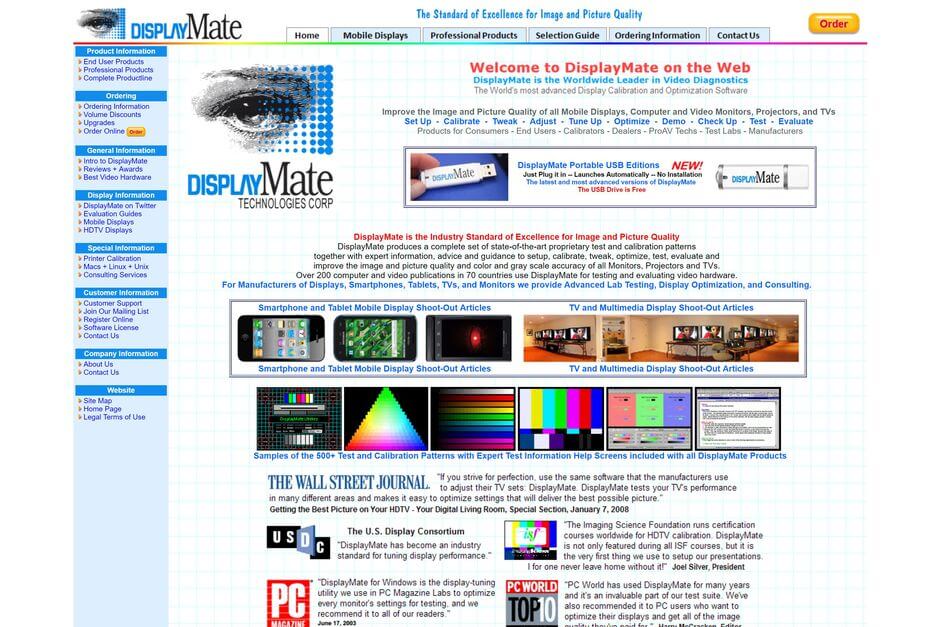
Perhaps you should not take the consumer properties of screens too seriously, because the factor of subjective perception is almost always superimposed on objective information. For example, in Southeast Asia there are a lot of people who like unnatural oversaturated colors, in our country there are also quite a few such people. On the other hand, broadcasting information poured into the ears by marketers in numerous discussions under reviews on YouTube is at least strange. In the end, I’ll be Cap and give a couple of banal tips: don’t stop thinking and be critical of any information received from brand representatives and the media, be able to analyze data and check facts, or just read resources and watch bloggers you can trust.
